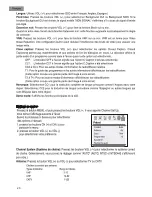
44
G
LOSSARY OF
T
ERMS
Audio/Video Inputs •
Jacks (standard RCA), located on the
back of the TV, used for external accessory devices. These jacks
are designed to receive higher picture resolution and offer
sound-connection options.
Auto Programming •
When activated, this feature scans for all
available channels from regular antenna or cable signals and
stores only active broadcast stations in the TV’s memory.
Channel Edit •
The feature that allows you to add or delete
channels from the list of channels stored in the TV’s memory.
Closed Captioning •
The broadcast standard feature that allows
you to read the voice content of television programs on the TV
screen. Designed to help the hearing impaired, Closed
Captioning shows dialogue and conversations while a TV pro-
gram is in progress.
Coaxial Cable •
A single solid wire normally matched with a
metal plug (F-type) end connector that screws (or pushes) direct-
ly onto a 75-ohm input found on the television or VCR.
Component Video Inputs
• Inputs that allow the separate recep-
tion of blue, red, and luminance signals. These inputs provide
the highest possible color and picture resolution in the playback
of digital signal-source material, such as the kind available from
DVD players.
Composite Video Input •
An input in which all the components
required for displaying the onscreen image are combined in one
signal.
High-definition Television (HDTV)
• High-resolution digital
television.
Incredible Surround •
False acoustic management of the audio
signal that produces a dramatic expansion of the wall of sound
that surrounds the listener and heightens overall viewing pleas-
ure.
Menu •
An onscreen list of feature controls available for you to
adjust or set.
Onscreen Displays (OSD) •
The wording or messages generat-
ed by the television (or VCR) to help you with specific feature
controls (color adjustment or programming, for example).
Remote Control Sensor Window •
The window or opening
found on the television control panel through which infrared
remote control command signals are received.
Second Audio Program (SAP) •
An additional audio channel
provided for in the Multichannel Television Sound (MTS)
broadcast standard. A monaural soundtrack included within the
recorded or video signal (usually containing a second language
translation for the displayed programming).
S-Video Input •
Signal input that allows direct connection of
high-resolution video sources, such as a satellite receiver, DVD
player, S (Super)-VHS videocassette recorder, or video games.
Provides improved picture resolution, sharpness, and clarity.
Tint •
TV function that allows you to change the general color
balance between cool and warm. Adjust tint according to your
personal preference.





































